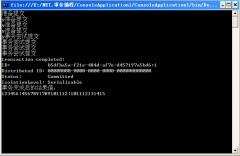C#下用P2P技术实现点对点聊天
即使你没有编写多线程应用程序的经验,也可能听说过“启动线程”“杀死线程”这些词,其实除了这两个外,涉及多线程方面的还有诸如“暂停线程”“优先级”“挂起线程”“恢复线程”等等。下面将一个一个的解释。
a.启动线程
顾名思义,“启动线程”就是新建并启动一个线程的意思,如下代码可实现:
Thread thread1 = new Thread(new ThreadStart( Count));
其中的 Count 是将要被新线程执行的函数。
b.杀死线程
“杀死线程”就是将一线程斩草除根,为了不白费力气,在杀死一个线程前最好先判断它是否还活着(通过 IsAlive 属性),然后就可以调用 Abort 方法来杀死此线程。
c.暂停线程
它的意思就是让一个正在运行的线程休眠一段时间。如 thread.Sleep(1000); 就是让线程休眠1秒钟。
d.优先级
这个用不着解释了。Thread类中有一个ThreadPriority属性,它用来设置优先级,但不能保证操作系统会接受该优先级。一个线程的优先级可分为5种:Normal, AboveNormal, BelowNormal, Highest, Lowest。具体实现例子如下:
thread.Priority = ThreadPriority.Highest;
e.挂起线程
Thread类的Suspend方法用来挂起线程,知道调用Resume,此线程才可以继续执行。如果线程已经挂起,那就不会起作用。
if (thread.ThreadState = ThreadState.Running)
{
thread.Suspend();
}
f.恢复线程
用来恢复已经挂起的线程,以让它继续执行,如果线程没挂起,也不会起作用。
if (thread.ThreadState = ThreadState.Suspended)
{
thread.Resume();
}
下面将列出一个例子,以说明简单的线程处理功能。此例子来自于帮助文档。
using System;
using System.Threading;
// Simple threading scenario: Start a static method running
// on a second thread.
public class ThreadExample {
// The ThreadProc method is called when the thread starts.
// It loops ten times, writing to the console and yielding
// the rest of its time slice each time, and then ends.
public static void ThreadProc() {
for (int i = 0; i < 10; i++) {
Console.WriteLine("ThreadProc: {0}", i);
// Yield the rest of the time slice.
Thread.Sleep(0);
}
}
public static void Main() {
Console.WriteLine("Main thread: Start a second thread.");
// The constructor for the Thread class requires a ThreadStart
// delegate that represents the method to be executed on the
// thread. C# simplifies the creation of this delegate.
Thread t = new Thread(new ThreadStart(ThreadProc));
// Start ThreadProc. On a uniprocessor, the thread does not get
// any processor time until the main thread yields. Uncomment
// the Thread.Sleep that follows t.Start() to see the difference.
t.Start();
//Thread.Sleep(0);
for (int i = 0; i < 4; i++) {
Console.WriteLine("Main thread: Do some work.");
Thread.Sleep(0);
}
Console.WriteLine("Main thread: Call Join(), to wait until ThreadProc ends.");
t.Join();
Console.WriteLine("Main thread: ThreadProc.Join has returned. Press Enter to end program.");
Console.ReadLine();
}
}
此代码产生的输出类似如下内容:
Main thread: Start a second thread.
Main thread: Do some work.
ThreadProc: 0
Main thread: Do some work.
ThreadProc: 1
Main thread: Do some work.
ThreadProc: 2
Main thread: Do some work.
ThreadProc: 3
Main thread: Call Join(), to wait until ThreadProc ends.
ThreadProc: 4
ThreadProc: 5
ThreadProc: 6
ThreadProc: 7
ThreadProc: 8
ThreadProc: 9
Main thread: ThreadProc.Join has returned. Press Enter to end program.
相关新闻>>
- 发表评论
-
- 最新评论 进入详细评论页>>




